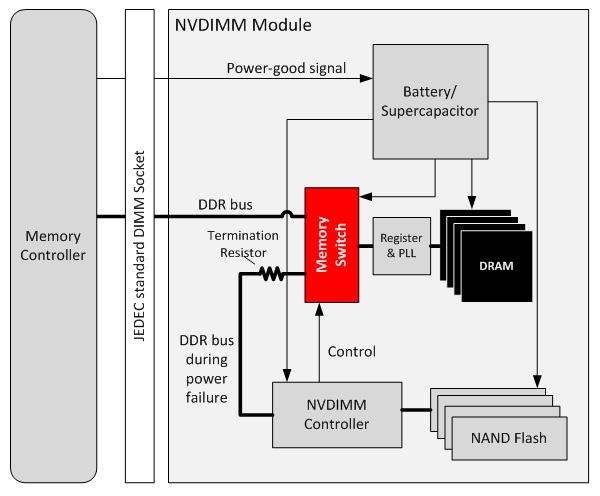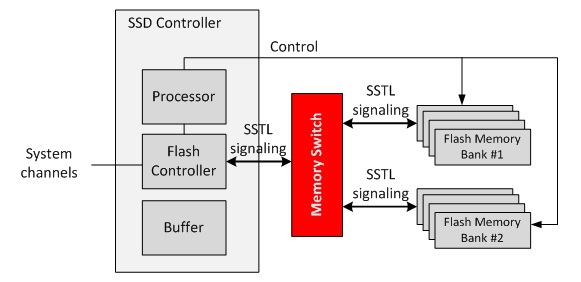SSZTBR4 january 2016 TS3DDR4000
Cloud computing is becoming popular in today’s computing environment by storing data and programs over the Internet instead of on local computer's hard drives. Mobility, agility, security, cost, and performance are just a few key benefits realized by migrating to cloud computing. At the epicenter of this trend are server and enterprise systems. As demand grows, so does a need for new technologies to improve transaction speeds, data integrity and data persistence of enterprise servers. The use of double data rate (DDR) memory switches enables a new cost-effective approach to architect some of these complex systems, as illustrated in Figure 1 and Figure 2.
 Figure 1 Using a Memory Switch in
NVDIMM Application
Figure 1 Using a Memory Switch in
NVDIMM ApplicationA non-volatile dual in-line memory module (NVDIMM) is a computer memory module that retains data during the sudden removal of system power, which could result from an unexpected power outage, system crash or normal system shutdown. In 2015, the JEDEC Solid State Technology Association announced the first standard to support DDR4 NVDIMM, which allows the DIMM to be plugged into a standard DDR4 DIMM socket found on most motherboards. The NVDIMM acts like a standard DDR4 memory to the system controller during normal operation, yet provides non-volatile data recovery capability during a system fault. One of the NVDIMM architectures, called NVDIMM-N, uses dynamic random-access memory (DRAM), NAND flash, and super-capacitors technology to provide persistent memory design.
The DDR4 memory switch is an essential piece of the NVDIMM-N building blocks. During normal system operation, the memory switch routes the DDR signals between the system and the DRAM for normal data access. When the system encounters a power failure, the charge stored in the super-capacitors temporarily powers the NVDIMM controller, which re-configures the memory switch to allow data from the DRAM to be copied over to the NAND flash. The NAND flash is non-volatile in nature, so the data is preserved even after the charge stored in the super-capacitors is depleted. When system power returns, the NVDIMM controller can re-configure the memory switch and allow the data from the NAND flash to be copied back to the DRAM. This permits the server system to retain important data, such as system cache and server status information.
Faster Data Transactions
With data expanding at an exponential rate in servers, high-capacity solid state drives (SSDs) are becoming more popular as the need to increase data throughput continues to rise. SSDs offer exceptional speed performance unmatched by traditional hard disk drives (HDDs), while reducing overall system power consumption.
As SSD capacity grows, it becomes necessary to increase the number of flash memory devices in each drive. Flash memory devices sometimes share the same control and data buses to communicate with the controller, but this causes increased loading for each communication channel during every data transaction. The extra loading becomes a bottleneck preventing potential increase in SSDs’ storage capacity.
 Figure 2 Using a Memory Switch in Load
Isolation Application
Figure 2 Using a Memory Switch in Load
Isolation ApplicationMemory switches can also improve system performance by providing load isolation. When the memory switch is enabled for one channel, the other channel is turned off and fully isolated. The memory switch prevents the unused channel from crippling data transactions.
Memory switches offer a quick and cost-effective way to improve system performance for servers and enterprise systems. TI offers a selection of high-performance memory switches, such as the TS3DDR4000, to help cloud computing become even more efficient and reliable.
How are you addressing performance in your cloud computing equipment? Log in to comment below.
Additional Resources:
- Learn more about of DDR switches on our product page.
- Accelerate development with the TS3DDR4000-EVM evaluation module.